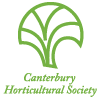Report on the March Meeting of the Fruit & Vegetable Circle
Speaker: Richard Smith
Topic: Pip & Stone Fruit
Richard originally worked for the Railways at Tower Junction, then spent some time fruit picking and ended up as their orchard manager. Now he works in management for Countdown logistics – they buy 450,000 cartons of fruit per week. Over the years there have been big changes in pest & disease control management.
Calendar spraying has given way to new biological sprays that kill selected species or specific stages in the insect’s life cycle eg. caterpillars. This specificity has enabled the beneficial insects to return, whereas the old broad spectrum sprays eliminated every insect.
Large pots can be heavy, so Richard recommends the spun fibre-glass pots from the Little Big Tree Co. in Sawyers Arms Rd, as they are strong and light. Instead of using prepared potting mixes, he uses plain compost but then adds the nutrients as required. Richard grows a wide range of fruit trees and prefers recent varieties as opposed to heritage ones. These he usually purchases from Waimea Nursery, Wairere Nursery and also the Little Big Tree Co. as these are all great places to find new varieties. Many of his trees are dwarf varieties that don’t usually need pruning. He suggests thinning early to produce good size fruit, and that is a good idea to pluck off some of the leaves too to encourage air flow. Black Spot can be avoided by having a clean orchard and using any rose or Yates fungicide if necessary.
Richard uses Codling Moth pheromone traps to monitor that threat, and if he captures 20 moths in a trap, this alerts him to then spray 17 days later just as the caterpillars are emerging. The traps are put out in Oct/Nov when the fruit is just beginning to grow. He is vigilant about frost protection and uses a sprinkler to guard against frost damage, so he has quite a few sleepless nights running in and out to put the sprinkler on!. He has been trying out a netting dome from Oderings for bird protection.
Varieties that Richard grows are:
- Almond- Garden Prince
- Nectarine- Garden Delight
- Omega plums, Plumcots- Scarlet Sunrise and Spring Satin
- Dwarf Apricots
- Red Boncretian or Barltet pears
- Pluot Plum which is an apricot hybrid, and very juicy.
- Pappel is a Nashi crossed with a European pear
- Dwarf cherries from Portstone Nurseries
- Red Kiwifuit variety has red seeds and reddish streaks in the flesh.
- Passionfruit grown the patio in pots
- Black seedless grapes- Sweet Saphire
He kindly provided samples of the Red Kiwifruit and some pears which we tried during supper at the end of the meeting.
Peter Saunders presented another slideshow on the happenings in his garden. He is harvesting peachcots, and potatoes. His chillies did well outside, especially the variety called ‘Gringo Killer’. There were good crops of Winter Cole and Buerre Bosc pears. Now is the time he begins the clean-up with diligent spraying to avoid brown rot. Peter empties old pot mixes onto his garden beds, and is beginning to make compost for his tunnel house. Composting materials need to be slightly damp, like a squeezed- out sponge; this combined with warm conditions will hasten decomposition. Compost heaps that reach internal temperatures of 55 Degrees will kill any weeds and seeds, but the heap needs to be at least a cubic metre in size for this to occur; roughly constructed heaps will benefit from turning every so often.
Phil Ducker then told us about his garden happenings: the harvest was in full swing. He encouraged us to save seeds of favourite tomato varieties; the seeds can be squeezed onto absorbent paper and left to dry for sowing next season and then store in the fridge for better longevity. He is planting broadbeans for a green manure crop and is spraying the fruit trees with copper now that the leaves are falling, and generally tidying up, which is vital to discourage disease carrying over till the next season.

